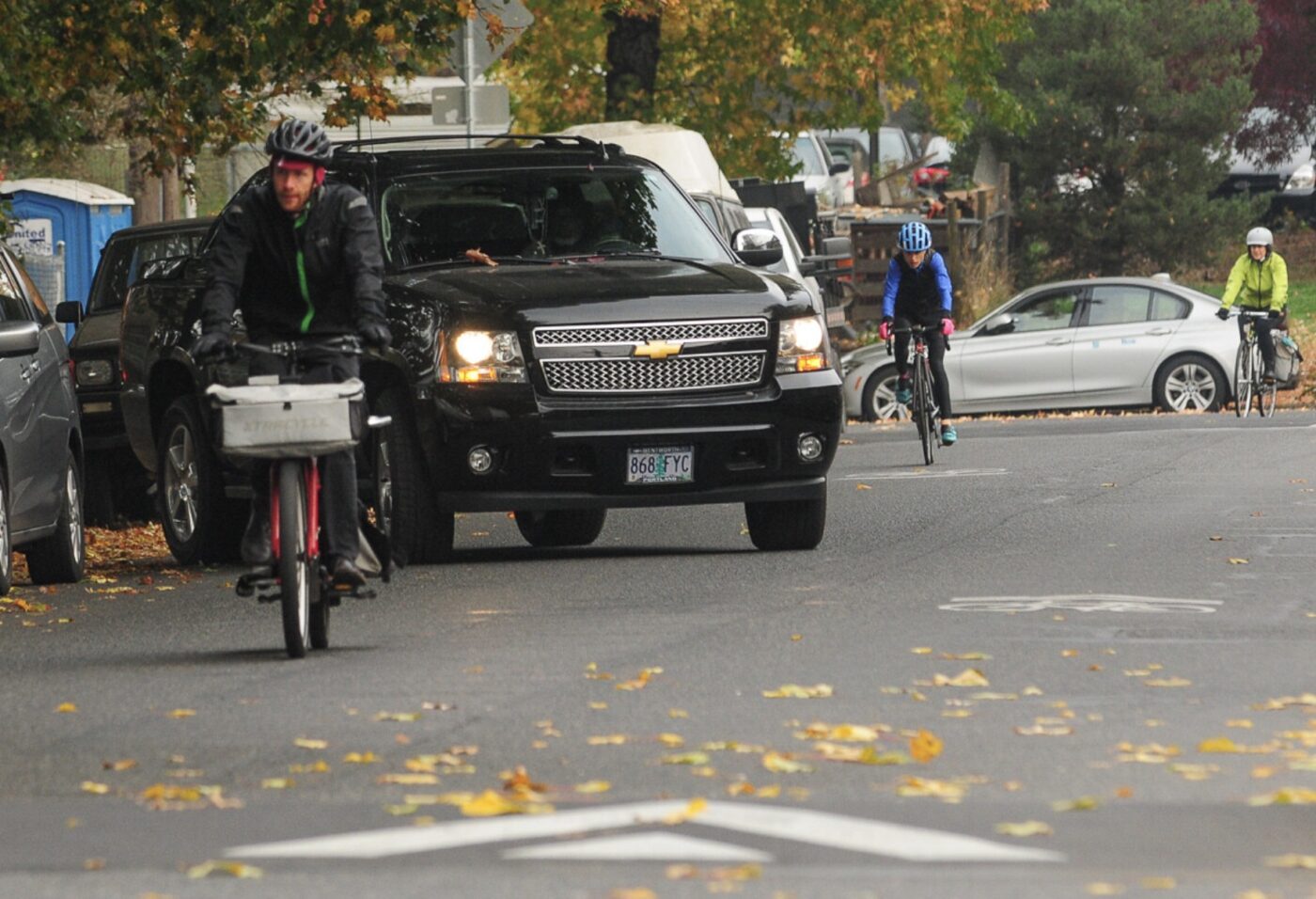
Lost amid the protests, politicking, and police statements at last week’s traffic safety press conference was a new report from Multnomah County that offers clear solutions to our staggering increase in crashes, deaths and injuries.
While Portland Transportation Commissioner Mingus Mapps said the focus of the event was to spark a “culture change” on our roads by focusing on individual behaviors, the County’s report recommends shifting away from behavior change and instead building a “safe system” by investing in safer road designs, changing laws to promote safer vehicles, funding health services to create safer vehicle users, and more.
For the first time ever, the County has gone beyond police records and engineering analyses to understand this problem. Instead, their report relied on data compiled from medical examiner investigation records. The report, Public Health Data Report: Traffic Crash Deaths in Multnomah County Taking a Safe System approach to address traffic-related fatality trends & contributing factors, digs into the data from 2020 and 2021 and comes at the problem from an epidemiological perspective.
At the press conference on Monday, Multnomah County Healthy Homes and Communities Manager Brendon Haggerty said the recent rise in traffic deaths and injuries is an “alarming situation.”
“It’s a leading cause of death, the trend is going up, and what’s especially alarming is that we see racial disparities,” Haggerty said in his remarks in front of City Hall.
The County’s report used data from 170 deaths and focused on several factors that influence crash injury severity: speed and roadway design; race, socio-economic and housing status; and use of intoxicants.
Excessive speed was found to be a factor in 42% of traffic crash deaths in 2020 and 2021. Over that same two-year time frame, the report found that a quarter of all traffic fatalities were homeless people and there’s twice the rate of traffic death among Black people as non-Hispanic whites. And when it comes to the use of intoxicants, four out of five victims tested positive for at least one. “That doesn’t necessarily indicate impairment,” Haggerty cautioned. “But it is a very high proportion.”
To turn things around, Haggerty said the answer is in the “safe systems” approach (of which the concept “vision zero” is just one element). Given the role of human behavior in traffic deaths, Haggerty said, “A critical insight of that approach is that humans make mistakes. And our system should be built so that when mistakes happen, they don’t result in serious injury.”
The County’s direct role will be to help people find more stable housing so they spend less time on the street exposed to high-risk intersections. They can also provide more behavior health and addiction support, so that people are in a healthier state when they get behind the wheel of a car.
On other measures, the County will have to use soft power to have an influence. This report is part of that effort.
Fewer people would die, the report found, if people would drive smaller cars. The report was one of the first from a local government agency to specifically identify the role larger, heavier cars have on the death toll. The County wants to work with state and city officials to increase the registration fee for heavier and taller, non-commercial vehicles.
The report offers a range of detailed recommendations. The ones that caught my eyes were: a 30 mph, countywide urban street speed limit that would be supported by investments in proven traffic calming projects; automated enforcement cameras; the use of more unarmed traffic officers; statewide laws on speed-limiting technology and alcohol detection systems in vehicles; and political opposition to all projects that “increase or do not decrease” vehicle miles traveled.
If Commissioner Mapps was looking for a plan of action, this report from the County would be a great place to start. I highly recommend giving it a read. Find the full report here.


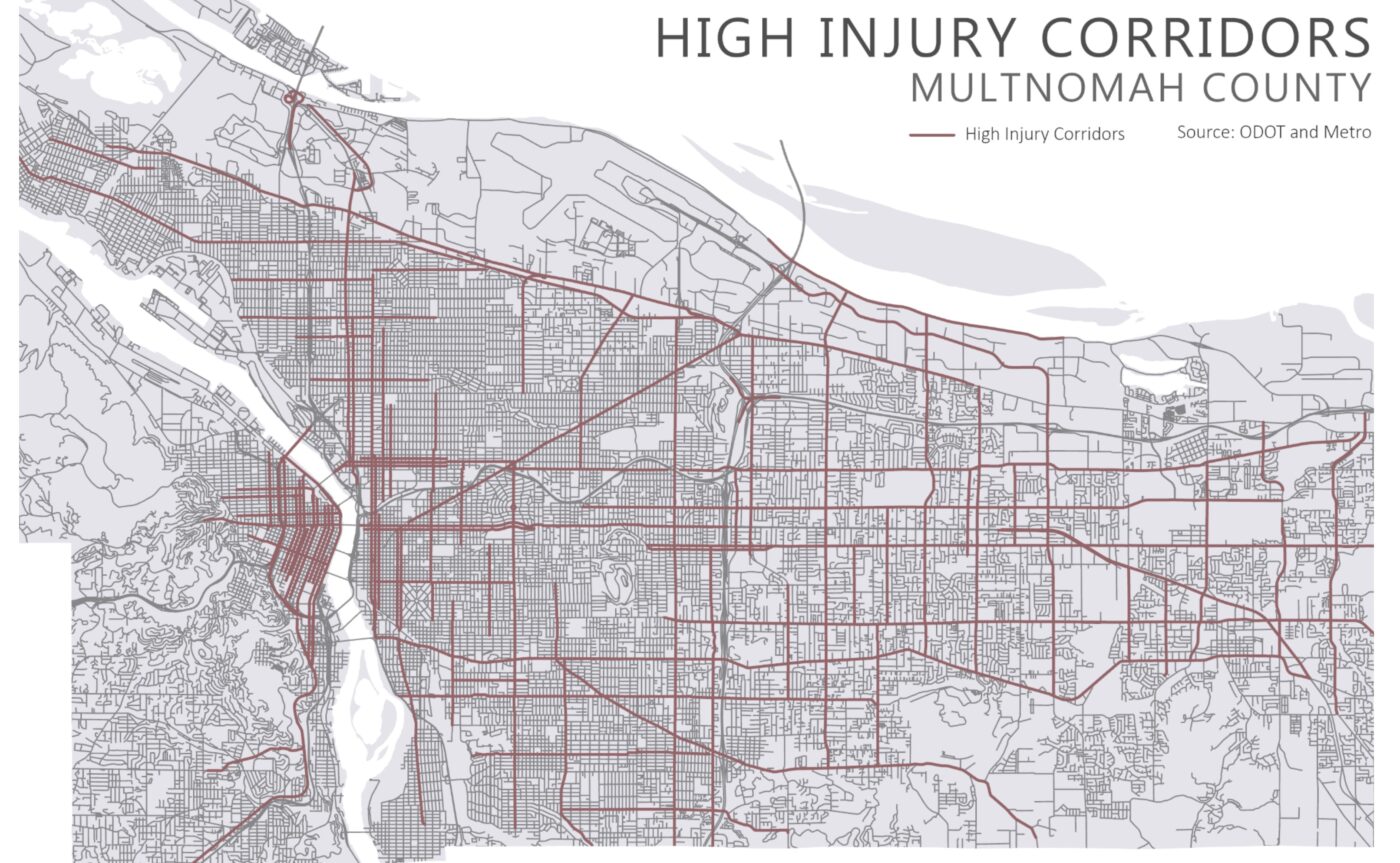
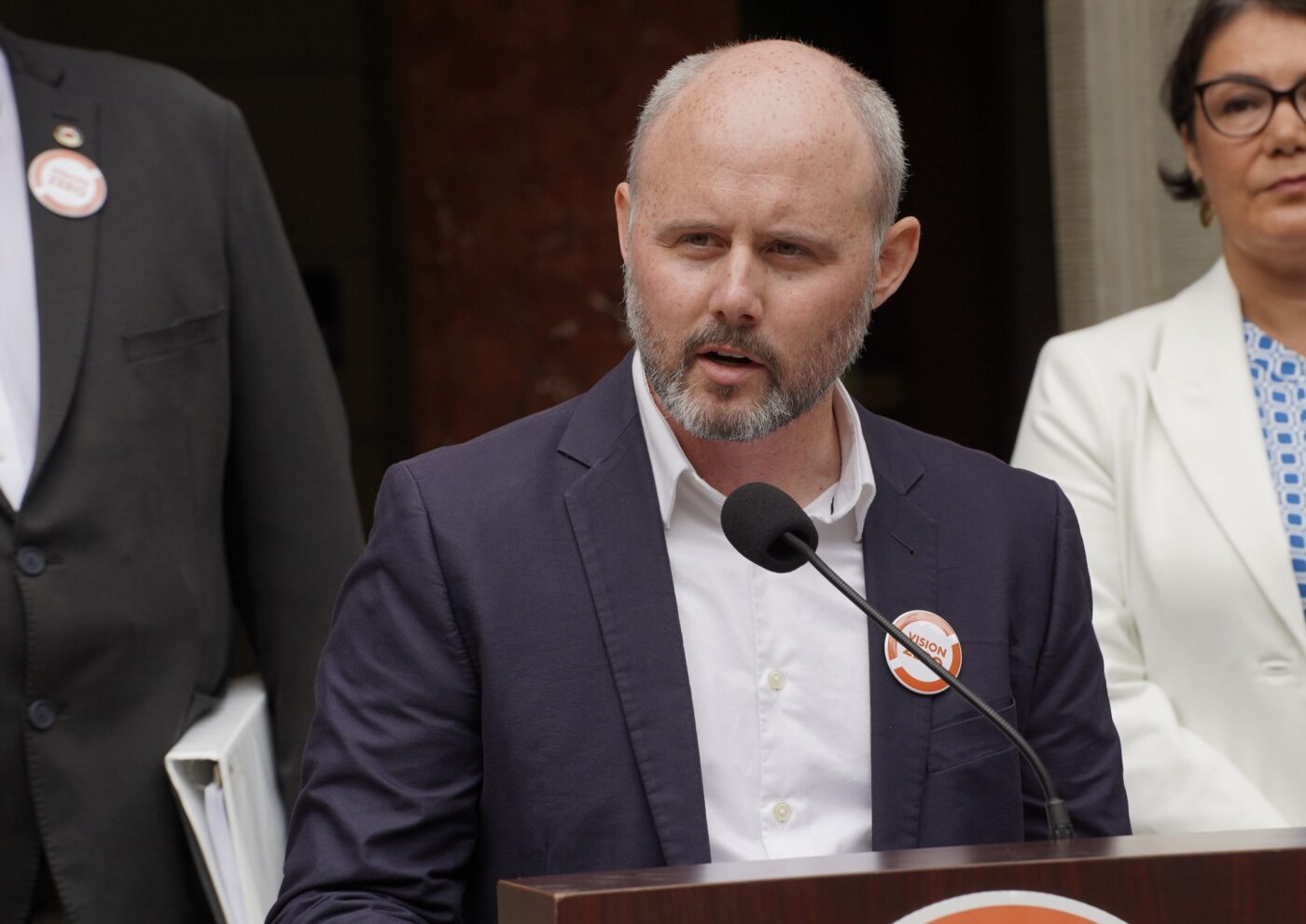
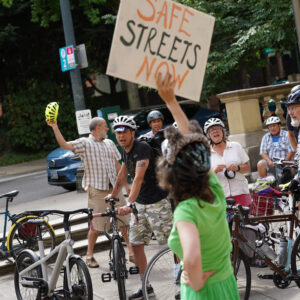
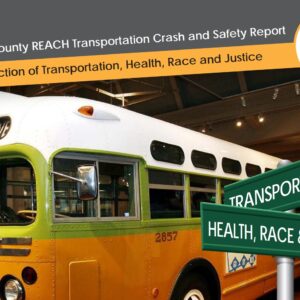

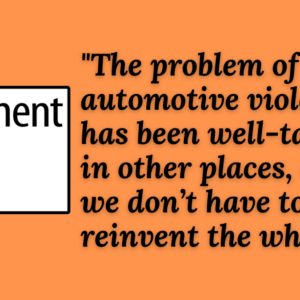
Thanks for reading.
BikePortland has served this community with independent community journalism since 2005. We rely on subscriptions from readers like you to survive. Your financial support is vital in keeping this valuable resource alive and well.
Please subscribe today to strengthen and expand our work.
Considering that urban roads owned by MultCo (e.g. Scholls Ferry’s MultCo section) are consistently so hostile to active transportation that nobody would even consider walking or biking on them, it’s going to take a lot more than reduced speed limits to move the needle.
Seriously, go look at the difference between WashCo’s section of Scholls Ferry and MultCo’s section. WashCo’s section has decent sidewalks in most places and the county is actively constructing new sidewalk. Immediately at the MultCo county line the road gains an uphill car travel lane, loses its sidewalk, and the speed limit increases; there are no near-term plans to improve the road up to Sylvan (in an area with no alternate routes, might I add). MultCo’s words don’t match MultCo’s actions.
Excellent point, noname. I recently tried walking on that section of Scholls Ferry and some guy in a truck (of course) did the “I’m gonna lay on my horn and honk you off the road since you slowed me down” thing. When gov’t authorities build roads that enable drivers’ WORST behaviors and impulses, drivers respond accordingly.
The reminds me of the Urbanist concept of “people don’t drive the speed limit, they drive at the speed which the road feels comfortable.”. That is to say that lowing speed limits doesn’t slow down cars without changing how traffic interacts with its environment. Think driving down a neighborhood you could comfortably drive 25 mph or may a bit over in contrast to take Lombard as an example the speed limit is set to 45 mph but people easily drive at 50-55 mph because the road allows drivers to comfortably do so. I like the shift in mindset by “investing in safer road designs, changing laws to promote safer vehicles, funding health services to create safer vehicle users, and more”.
Multnomah County does not own any part of Scholl’s Ferry Rd, its owned by ODOT. Just because a road is inside a county or city does not mean its owned or maintained by them.
That is a patently false statement.
ODOT owns only a very small section, from the 217 freeway onramp to about Cascade Avenue I think (and this is a completely different section from the one I’m talking about, between Allen and Highway 26). Just because it has a route number (210) doesn’t mean that it’s owned by ODOT. Take MLK for another example: it’s owned by PBOT despite its ODOT route number.
https://www.oregon.gov/ODOT/Data/Documents/SLC_Hwy143.pdf shows the tiny section owned by ODDT; the rest is all county ownership.
Unfortunately the recent track record for Multnomah County managIng polices and tax measures has been a dismal failure. Vega Pederson gives me no confidence she can turn things around.
1) Homeless Tax: FAIL
2) Preshool Tax: Fail
3) Harm Reduction Plan: FAIL
I don’t see why they would do any better with traffic safety. Their list looks like mostly a laundry list of aspirational, far in the future solutions, several with limited proof of efficacy.
And of course the desperately needed full return of traffic officers was nowhere to be seen. The downward spiral of traffic violence continues it appears.
I like the blanket 30mph limit. That would be nice. Of course, with enforcement.
When it comes to speed limits, I wonder what is it going to take to get them to actually treat the number as the limit? Like, have speed cameras issue a ticket at 1mph over. Or if we’re really worried about margin of error, find out empirically what that margin is and use that as the basis. Whatever it is, 10mph is unacceptably far over the limit. When the speed limit is 25, letting people off for going 34 makes no sense.
Why driving *exactly* at the posted speed is rarely possible: https://www.roadandtrack.com/car-culture/car-accessories/a32026968/are-speedometers-accurate/
That said, if you want people to drive (say) 30mph the answer is obvious – post the speed as 25, give a ticket for 35 and over time the mean speed through that section will be about 30mph.
Remember – we aren’t counting on humans to be infallible. We’re designing the road to get our intended outcome *in spite of* human fallibility.
The speedometer issue is not my problem and it’s irrelevant. Nowhere did I suggest people should stay exactly at the speed limit, I said they should treat it as a limit. That means go under it. Nobody goes exactly 10mph over the limit now either, they just treat the limit as (limit + 10mph) and act accordingly.
But sure, we either need to treat it as a limit or codify the 10mph buffer explicitly and lower all our limits by 10mph. I’m happy to put up signs that say Ainsworth is a 10mph street if that’s the way we want to do it. It’s six of one, half a dozen of the other, they’re the same thing. It’s just stupid to have signs that say one thing but they don’t mean it.
Sounds good to me!
A small quibble. This sounds a whole lot like Vision Zero, which the city (county too maybe?) adopted eight (?) years ago. What specifically have those who adopted this vision been doing/not doing all of this time?
This was pure dark comedy.
Given that “vision zero” is, by definition, a “safe systems” approach the multnomah county employee either has no clue what vision zero entails or, more likely, is cynically using Portland’s failure to implement vision zero to spin their own completely unfunded hopium (masquerading as good-faith and actionable report).
https://www.portland.gov/transportation/vision-zero/making-streets-safe
“With the Vision Zero Action Plan, the Portland Bureau of Transportation has set a goal of eliminating all traffic deaths and serious injuries by 2025.”
“The County’s direct role will be to help people find more stable housing so they spend less time on the street exposed to high-risk intersections. They can also provide more behavior health and addiction support, so that people are in a healthier state when they get behind the wheel of a car.”
Really though, does anybody actually believe this?
That is pretty tasty sounding carrot, I wish they would add a stick: get unregistered/unlicensed/unsafe cars OFF the road.
Some great ideas in this report, let’s hope we see some or most of the suggestions turned into action.
In my opinion, hoping that unfunded plans/reports are implemented helps enable continued inaction.
A 16 page report and the word BUDGET does not appear even one time. Multnomah County is not serious about reducing crashes. Recommendations and “policy focus” is just talk. Put your money where your mouth is. You get what you pay for. If you don’t pay for safety, you won’t get safety.
How about MCHPHAB change just one sentence to say:
“… our recommendations as a Local Public Health Authority for improving traffic safety through design, operation, and BUDGETARY CHANGES THAT focus on:
❖ Safe Speeds ❖ Safe Vehicles ❖ Safe Road Users ❖ Safe Roads ❖ Optimizing Emergency Medical Services ❖ Safe Mobility for all Modes of Transportation
Can the county actually do any of this stuff itself? Or will they be paying the cities to do it? Or are they hoping that the cities do it on their own dime?
If all they’re doing is hoping that somebody else will do the work and foot the bill, then we all know how this story ends.
No.
This kind of reminds me of that “Step 3: Profit” meme. There’s a missing step in the report.
The list of proposed policies mentioned in the report is very reasonable and would head us in a better direction. The problem of automotive violence has been well-tackled in other places, and we don’t have to reinvent the wheel.
What’s missing is Step One: building the political will for those policies and standing up the transportation alternatives that allow people to go about their lives without feeling like their freedom has been stolen.
Many of the policies would force driving voters to endure slower travel, *more* commuting time, with worse traffic, or even potentially force drivers onto bikes or mass transit unwillingly. As much as us transport nerds understand the benefits of that tradeoff, the average voter will likely *hate* it.
There’s no guarantee that voters will always be able to live near their job, or near the current bus lines- not to mention people working multiple jobs every day. Some people have co-parents who live on the opposite side of town, but need to shuttle children home from school daily while the co-parent is at work. Contractors work *all over* the metro area. Some people cannot even fathom the idea of riding a bike in the rain in the winter.
We all have a limited number of hours per day and we have to acknowledge that these policies would increase the amount of time people “spend” on getting around. Less recreation time, less work time, less family time. That’s a hard sell.
Without transportation alternatives in place, forcing people like this into a slow-car or low-car life will probably generate a lot of resentment.
Even if the policies work, would voters care? Just reading the article, a quarter of victims were homeless and four out of five tested positive for intoxicants. Most people probably think “it can’t happen to me”… and from those figures, they’re not entirely wrong.
That’s why the killing of Jeanie Diaz was such big news: she was a “normal” person doing a “normal” thing during “normal” daylight hours. This problem usually isn’t “personal” to the average voter: they don’t see themselves at risk.
As long as this problem is concentrated in less politically engaged constituencies, there will be less political will for the kind of shift that would save lives.
So I wish our leaders would spend more time creating politically attractive alternatives and thinking about how to generate political will for the shift. In a democracy, policy is accountable to the voter, and voters don’t generally vote for deprivation. In the absence of a personally motivating purpose and attractive transportation alternatives, all we have to sell is… slower driving times and traffic. That’s a problem!
COTW!
Politicians need to do better, and local media, too. I sent an email to OPB this morning complaining that they are repeatedly reporting on a single potential death from heat in a way that just sensationalizes it and stokes fear rather than contextualizing it. I asked them to examine the effects of a week of heat on the Portland Metro area and our state and local response to it and compare that to a week of traffic violence and our state and local response to it. Solutions for future heat events include housing, more trees, implementing climate policy- but it will rely on global cooperation to some extent. Traffic violence is mainly Portlanders killing other Portlanders, mostly through carelessness- we could fix that pretty quickly IF we had a strong, bold, coordinated effort.
I like the County suggestions and I hope they implement them as quickly as possible. There are quite few roads I have biked on that would benefit form a 30 MPH speed limit. I hope Portland and the state follows suit- there is no good reason for Greeley, Lombard, Marine drive, etc to be faster than 30 mph.
County roads:
https://multco.maps.arcgis.com/apps/webappviewer/index.html?id=831781f246294c6699a1e4e798c643e1
Step 1: Write well articulated and insightful post on BikePortland
Step 2: ???
Step 3: Profit!
Well, there is a lot to unpack there, Charley.
Any change is going to bring resentment. Think of all the beautiful who pose 15 minute walkable cities, and their reasoning.
Of course not, that’s why you have to overhaul the transit system before people accept those kinds of changes. Having to travel on other peoples’ schedules is your hard for many people to accept. Being able to get from your home directly to your destination is a powerful thing. Taking public transit would also mean having to deal with other people a lot more.
A quarter is still only a quarter. Some voters will care. It is really sad that some just won’t care. What do you think these politically attractive alternatives that you wish our leaders would spend more time creating Would be?
My preferred transportation alternatives:
– faster, safer, more affordable, more convenient transit options (bus, train, etc)
– faster, safer, more convenient cycling routes
Some of us enjoy the good feeling of “helping the environment” or “getting some healthy exercise outside while human-powered commuting,” but most people just want to get from A to B in the least amount of time, safely, and cheaply.
When I lived in NYC, most everyone took the train (or the bus). It was great because it was fast, safe, affordable, and convenient. No one I knew complained about traffic because none of us had or needed a car.
Maybe, instead of creating “transportation alternatives” for motivated environmentalists,
we should be making “transportation competitors” so normal people just don’t want to drive.
Yes, More people would probably use public transit if it was fast, safe, affordable, and convenient. Competitive, instead of alternative.
Comment of the week! Thanks Charley!
You wish? Keep on wishing, Charley.
.
Until there is a grassroots* movement that demands transportation alternatives via direct action, protest, and/or hardball electoral politics our current crop of feckless, corporatist elected officials will do #$%$ all.
It’s fascinating to me that as our city’s traffic violence crisis worsen active transportation orgs continue to become more tame. Bikeloudpdx now resembles the BTA in their focus on do-goodery and “education” and the head of the streetrust had the gall to obsequiously thank ODOT for money at a press-conference that addressed the slaughter of vulnerable traffic. With active transportation orgs like these, nothing will change.
* radical would be a better word but bike portland commentators are afraid of this word. they would rather “wish” instead.
Many have tried. So what are *you* doing about it?
I have irreconcilable sociopolitical differences with YIMBY-oriented folk so I have zero interest in Bikeloud or TST. However, if a more radical org willing to “risk” direct action were to coalesce, I would be doing something about it. (Given the demographic changes in this city, I think this is unlikely.)
No one is stopping you.
So a Mult. Co. health official doesn’t understand the definition of impaired? .” Lawmakers made up a legal line, “Driving Under the Influence of Intoxicants” with a Blood Alcohol Content of .08% but the only safe driving limit is .00%.
https://www.healthline.com/health/alcohol/blood-alcohol-level-chart#charts
That state has sanctioned a level of impaired, that is diminished driving ability and acceptable risk to other people that I’ve not consented too.
*** Moderator: deleted a couple of phrases, name calling ***
I don’t understand your definition of safe. Is driving at 0% BAC “safe”?
Here’s one thing that should be done. Make it easier to report an “at-risk driver.”
https://www.oregon.gov/ODOT/DMV/pages/at-risk_voluntary_reporting.aspx
You make it so if a driver gets reported so many times w/in a specified time frame, that the DMV suspends their license.
I take it you do not like the fact that the report requires the drivers name and date of birth so DMV can identify the person behind the wheel. The license number is not proof positive for identification. Registrations can have more than one name listed. The owner(s) could have loaned the vehicle out to friend or family. It is a new owner and they have not registered it yet. It could be a company vehicle. If you are going to suspend a someone’s license than DMV has the legal responsibility to identify the driver.
My take on automated traffic enforcement is we fine the vehicle owner/registrant. It is the owners’ responsibility to vet whomever they lend their vehicle. In other words, if you let someone drive your vehicle who then violates the automatic enforcement system, that’s on you. Parents of teenagers, probably won’t like this, but it might encourage them to think harder about driver education and focus more on responsible behaviors from the outset.
And just like ticketing, reporting risky drivers would happen after the fact. Sometimes that would mean awful tragedy first, ticketing/reporting later. Changes in street infrastructure are the key to getting our streets under control
Street infrastructure is not the “key” as numerous street improvements have demonstrated. We need to make streets safer and more pleasant places to be. But street design is a small part of the equation. The problem is motor vehicles that are designed to be inherently unsafe.
Zero deaths is an aspirational political statement. There is no real intellectual challenge to achieving it, the problems are all political and conflicting values. People want to get where they are going as fast as possible. A few people getting killed isn’t enough to make them value safety over convenience.
But “as fast as possible” is a cultural expectation and 20 miles per hour is still too fast. So start by reducing freeway speeds to 45 mph (not the speed limit, the speed). That will reduce congestion and emissions. But it will also start to create a culture with lower speed expectations. Then slow city arterials to 20 mph. Then reduce business district speeds to 5 mph. Then require controls on acceleration and finally give self-driving cars owners absolute responsibility for the safety of pedestrians and bicyclists. And dogs, cats and squirrels. In essence demand that motor vehicles be safe.
Really…Do tell.
Infrastructure. Just a different infrastructure. Yes, oh course that’s only part of the equation.
Yes, do tell. Portland has been investing in better infrastructure for at least the last 25+ years. Has it been enough? No. Infrastructure changes are expensive, disruptive and take a long time.
Most are unnecessary if there wasn’t the overwhelming committment to accomodating unsafe motor vehicles. Bike lanes and sidewalks never really served pedestrians and cyclists. They were designed to get them out of the way of personal motor vehicles. So long as that is the case any infrastructure improvements are going to be at best imperfect solutions. They do have the advantage of creating jobs ..
So there is an actual report? They should have lead with that.
The reason Vision Zero and other “safe systems” approaches will never work in transportation is that our so-called transportation “systems” are not really systems at all: they are a strange patchwork of historical approaches, practices, and infrastructure that are constantly shifting. The truly fatal flaw in applying systems thinking to transportation is the fact that the driving (pun intended) force in the “system” is almost completely outside of the control of the “system” parameters, and that would be the deeply flawed *VEHICLE OPERATORS* who exercise outsized influence within the so-called system.
When our great-grandparents designed a network of roads in the 1920s and decreed that individual drivers would control their own vehicles on that network, the idea of a system died right there. So as long as individual drivers exercise almost complete agency, there can be no system.
Quick example: Recently I was driving my fuel-efficient, subcompact car on I-205, when traffic slowed to a crawl, as it so often does. After five minutes of 5 mph driving, I crept up to the cause of the slow-down: a fender bender on the right shoulder, with police, fire, and EMS response. As I left the crash site behind and traffic sped up, several SUVs came barreling up behind me, crossing multiple lanes and weaving dangerously to get ahead. I could imagine the drivers thinking, “I didn’t deserve to be delayed! And now I have every right to drive as fast and as dangerously as I want!”
This type of entitled behavior trumps Vision Zero every time, so until Multnomah County controls the gas pedals and the steering wheels of individual vehicles, their whole effort is dead on arrival.
so why does Vision Zero work so well in other countries?
I haven’t heard that those authorities control the gas pedals and steering wheels of people’s private autos there either.
Sweden was among the first to test intelligent speed assistance (controlling gas pedals) in the mid 2000s which led to EU wide mandates to control people’s gas pedals.
https://road-safety.transport.ec.europa.eu/statistics-and-analysis/statistics-and-analysis-archive/esafety/intelligent-speed-adaptation-isa_en
You learn something new every day on bikeportland.
Thanks Mitt.
Other countries are more civilized and don’t have the “Me, me, me, it’s ALL about meeeeee” approach when it comes to public safety and courtesy/rules. In other countries the general population works together for the good of everyone. Not so the US. This is my opinion only, I don’t have citations. Many other countries also have a different, possibly less stressful approach to living than we do here. People here have schedules that are jam-packed beyond what the clock will permit. On our roads that means that people will cut through neighborhood streets to save 30 seconds of waiting at an intersection, without giving a thought to the people whose streets they are racing through or the kids or pets could be harmed. People also get very impatient when they cannot move as fast as they want to; so very irate, irrational drivers here.
If I could have moved away from the US (and qualified to get into another country) I would have years ago. In my opinion this country is doomed.
Fred, I agree that we have “a strange patchwork of historical approaches, practices, and infrastructure”, but that doesn’t mean we don’t have a system. It’s a bizarre claim, really, kinda like Margaret Thatcher’s absurd claim that “there is no such thing as society. There are individual men and women[…]And no government can do anything except through people, and people must look to themselves first“. We have traffic lights, speed limits, sidewalks, etc., etc., functioning, albeit poorly, together, obviously as a traffic system.
There are sooo many examples of how to change our traffic system to improve safety for everyone. Why not check out “Traffic Calming is Everywhere in the Netherlands“?
Let’s take a moment to celebrate and double down on the culture that Portland has helped make possible. This creative, well produced video sums up a large part of the vision of the Mult co statement.
https://youtu.be/XGPvHiUohas
Ya gotta love Portland, that was great! Thank you!
“detailed recommendations [like]. . . political opposition to all projects that ‘increase or do not decrease’ vehicle miles traveled’
Housing and other development increases vehicles miles traveled. There is no sugar-coating in-fill and other density or sprawl. It’s more cars and more miles. But I don’t see the county opposing development in general.
The silver lining in Portland’s growing set of livability issues has been the trending population decrease. This means reduced vehicle miles because there are fewer drivers. Maybe now we can decrease the UGB?
“The Wrong Way to Set Speed Limits” video. This helps explain why Portland roads may be so dangerous.
How long has it been since PBOT used the 85% rule to set speed limits? It has been recognized as a bad idea for at least 25 years. There may be places where its still used, but it explains nothing about Portland’s roads. I think its a straw man.
The real problem is the basic engineering idea of tolerances. You design something with a lot more capacity than is needed. The problem when you do that with streets for motor vehicles is streets designed for more speed than is safe for the rest of us. And people drive at a speed that feels safe to them, not to someone trying to cross the street or on a bike who doesn’t have a steel shell around them.
I don’t know if Portland uses the 85% rule, specifically, but indeed, as the video illustrates and you write, we have “streets designed for more speed than is safe for the rest of us.” It’s obvious that streets near my house like Alberta and Killingsworth are mixed-use, but cars get preference in the design: “Stroads“.
We agree on the problem. The question is what to do about it and how do we talk about it in a way that leads to real change. The idea that there are smarter engineering solutions and smarter traffic engineers will solve the problem is a dead end. They can and should contribute to the solution, but they shouldn’t be the focus.
A bigger PBOT budget or a different PBOT budget is not where our energy should go. It should go into insisting that motor vehicles be made to operate in a way that is safe for pedestrians and bicyclists.That means reducing the number of vehicles, their speed and taking the responsibility for their safe operation out of the hands of fallible human beings (and giving it to less fallible computers).
BTW Chuck Marohn, the founder of Strong Towns, is small town highway engineer from rural Minnesota where towns’ suburban style development sprawls out along state highways. He is an engineer who wants to reform the way roads are engineered. So he repeats 30 year old talking points about ideas for engineering streets that he learned at new urbanism conferences. He has no personal experience with urban transportation or even urban streets in large cities. Its a mistake to let his ideas set the agenda.
Thanks, Ross.
It’s not clear from what you write why the designs for slower speeds and safer streets created by Dutch traffic engineering are “dead ends” for our problems in Portland. It’s, as well, unclear how your preferred means of reducing traffic deaths — less vehicles going slower and controlled by computers — are going to happen in, say, the next 5 or 10 years in Portland or anywhere else. By what means or methods are your totally not “dead end” goals achievable?
It doesn’t matter to me who Marohn is if he’s correct; what’s erroneous about his ideas?
You are not going to get any significant changes to the built environment in 5 or 10 years. Marohn’s ideas have been a common part of the discussion in Portland for at least 25 years. They will continue to be part of the discussion for at least another 25 years. Just look how long it took to get something as simple as curb cuts for wheel chairs.
Its useful to remind people that the design of our street infrastructure enables auto-dependence. But its auto-dependence that drives the problem. Debates over on-street parking being the classic example.
The long term effect will be to extend auto dependence since those investments are designed to facilitate it. Its the “sharrow” effect. Traffic engineers all over the country have found they can make a street “bike friendly” by painting it. But many/most sharrows aren’t really shared at all because the motor vehicles don’t travel at bike speeds. You share the lane on a bike at your peril. You can make the same argument that bike lanes are there so motor vehicles don’t have to share streets with bikes.
Even painted crosswalks create an illusion for motor vehicles that they only need to watch for pedestrians where there is paint. And traffic engineers refuse to paint the crosswalks in many places because they falsely encourage pedestrians to think they can cross safely. A plan to require painted crosswalks at bus stops was shot down at Metro years ago because many suburban stops were on streets where it wasn’t safe to cross. The traffic engineers acknowledged people would cross to get to the bus, but they didn’t want to encourage it.
In short turning this into an infrastructure engineering problem will not get us to a safe community for walking, biking or using transit. Its a band aid. Band aids serve a purpose, but they don’t stop people from cutting their finger with a sharp knife.
Reduce traffic speeds for personal motor vehicles to 5 mph and the problem goes away. Walking and biking become safe and just as fast and transit becomes faster. People will strill drive, but a lot fewer miles creating an enormous reduction in emissions and far less auto traffic. Its an easy technical solution that will be extremely difficult to implement socially and politically. Its easier to paint sharrows on the street and more profitable to reconstruct the street.
Thanks, Ross.
You write, “[T]he design of our street infrastructure enables auto-dependence.” Yes, this is why many push for transit engineering that re-focusses use for other modes of transit.
Your examples — crosswalks, “sharrows”, speed limits signs — are all examples of engineering. Maybe you think they’re poorly implemented, but they’re all still engineered street design. What will make our streets safer? Leaving it up to drivers to sober up and become more kind and compassionate?
I’m all for reducing speeds to 5 MPH, as you suggest; does this seem more realistic to you than changing how our roads function? Mostly what I get from your posts is that you feel there’s no hope or possibility for changing our dangerous streets, counter-examples be damned. I truly don’t understand where you’re coming from.
No mention of funding. Due to the taxes passed on “high earners” recently and the lack of services provided the tax base is leaving Multnomah County for greener pastures. I don’t see how any of this will funded unless we offer reasonable taxation combined with providing adequate essential services. I’m definitely considering getting out of Mutlnomah County.
https://www.axios.com/local/portland/2023/08/16/portland-migration-leaving-cost-multnomah-county-1-billion
The “20 is plenty” speed limit program could be expanded to the whole of the city and county without the crazy expenses associated with restructuring roads.
Good riddance!
If more “high earners” flee we might see some reverse gentrification and increased affordability in this sorry city for the rich.